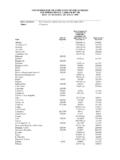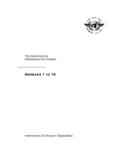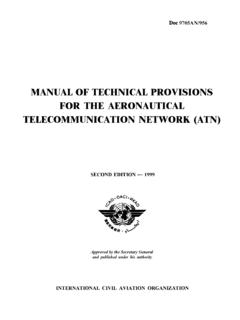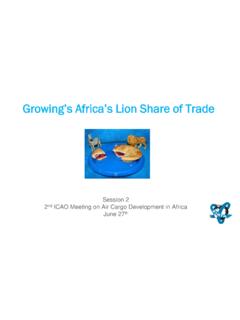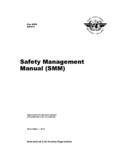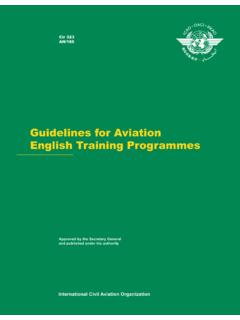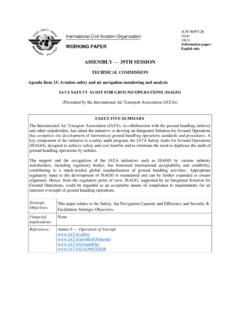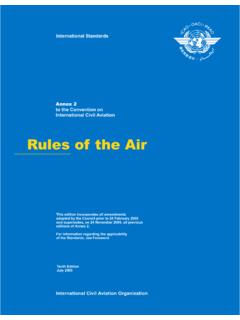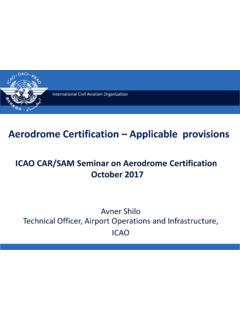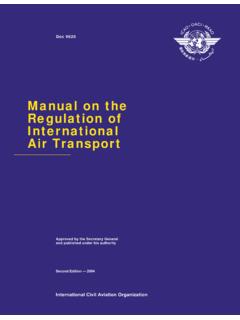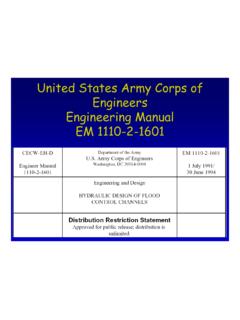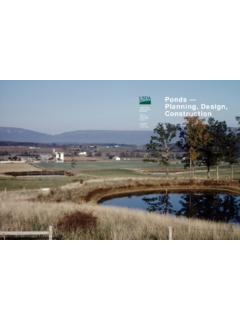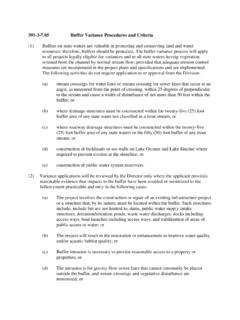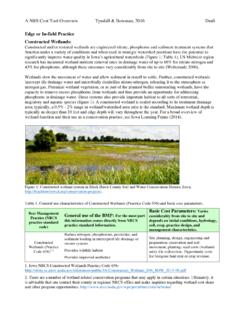Transcription of Waste Management at Airports - ICAO
1 Waste Management at AirportsECO AIRPORT TOOLKITENVIRONMENTW aste Management at AirportsECO AIRPORT TOOLKITENVIRONMENTI nternational Civil Aviation Organization (ICAO)999 Robert-Bourassa Boulevard, Montr al, Qu bec H3C 5H7, CanadaOUTLINE1. INTRODUCTION 52. DEFINITION OF Waste 53. TYPES OF Waste MUNICIPAL SOLID Waste (MSW) CONSTRUCTION AND DEMOLITION DEBRIS (CDD) Waste FROM AIRCRAFT FLIGHTS (DEPLANED Waste )
2 INTERNATIONAL Waste COMPOSTABLE AND BIODEGRADABLE Waste HAZARDOUS AND INDUSTRIAL Waste LAVATORY Waste 74. Waste Management PRINCIPLES Waste HIERARCHY Waste AVOIDANCE Waste REDUCTION Waste RECYCLING
3 Waste TO ENERGY Waste DISPOSAL 95 Waste Management APPROACH - GOALS, ORGANIZATION AND RESPONSIBILITIES Waste AUDIT Waste Management AND REDUCTION PLAN IMPLEMENTATION MONITORING AND EVALUATION
4 METRICS RISKS AND OPPORTUNITIES 126 IMPLEMENTING A Waste Management PROGRAM STAKEHOLDER ENGAGEMENT AND EDUCATION (COMMUNICATIONS) Waste SURVEYS, AUDITS, STATISTICS WITH PROPER METRICS Waste INFRASTRUCTURE WITH SIGNAGE (COLORS, ICONS, TERMS) ECONOMICS: INTRODUCTION OF POLLUTER-PAYS-PRINCIPLE 167. Waste RECYCLING: DEVELOPMENT AND DESCRIPTION OF THE PROCESS MSW RECYCLING CDD RECYCLING ORGANIC Waste : DESCRIPTION OF VARIOUS PROCESSING ROUTES 188.
5 RESIDUAL Waste (WHAT S LEFT?) LANDFILL AND INCINERATION 199. CIRCULAR ECONOMY 1910. REFERENCES 22 Waste Management at Airports51. INTRODUCTIONE very airport must manage Waste , and implementing efficient and cost-effective Waste manage-ment practices presents many challenges.
6 There is a wide range of sustainable practices that can make the Management of Waste at Airports more economic and better for the environment. Fur-thermore, successful airport Waste Management implementation has the potential to positively impact airport authorities, customers and the surrounding community at large. Airports are local entities. Waste Management at Airports are therefore generally reliant on na-tional/local regulation, drivers and realities. For instance, a municipality with Waste reduction tar-gets can influence an airport operator s Waste Management policy. Additionally, stakeholder s ar-rangements with the airport operator also vary from place to place ( contracts, responsibilities) and may impact the ability of the airport operator to influence its stakeholders.
7 In this e-publication Waste Management at Airports general principles and approaches will be addressed. It will provide the basics of Waste Management at the airport site, including in partic-ular environmentally friendly practices, and the new concept of circular economy, which can also minimize DEFINITION OF WASTEFor the purpose of this e-publication, Waste will be considered as any type of unwanted or un-used products/materials/substances that happen to be produced and/or arrive at the airport site and that needs to be given a proper treatment. Waste Management , therefore, will be the process of handling the Waste , which could come from aircraft (domestic/international), tenants, mainte-nance activities, aircraft and ground vehicles operations, offices, construction and so on, as well as dealing with the different requirements of these different types of Waste .
8 However, in reality there is no single definition of Waste , especially if one is trying to combine a common understanding of the different practices, regulations and levels of maturity of Waste Management , including environmentally sound performance around the globe. The Oxford dic-tionary defines Waste , in general, as Unwanted or unused material, substances and by-products 1. The Basel Convention on the control of Transboundary Movements of Hazardous Wastes and their Disposal defines wastes as substances or objects which are disposed of or are intended to be disposed of or are required to be disposed of by the provisions of national law. It also defines what can be considered as an environmentally sound Management of hazardous wastes or other wastes: practices that ensure that these wastes are managed in a manner which will protect hu-man health and the environment against the adverse effects which may result from such wastes.
9 The majority of this document focuses on the extent to which the materials, substances, and by-products of the modern aviation system are Waste and the choices Airports have when decid-ing what to do with it. For the aviation industry, two other considerations are of primary concern, 1) is the Waste interna-tional, and is it hazardous Waste ? States often have their own regulation defining specific treat-ment for international Waste and airport operators must follow them. For example, the Canadian International Waste Directive defines International Waste as any Waste removed from aircrafts .. including things that are forfeited or voluntarily surrendered by international travelers arriving in Canada.
10 2 The Basel Convention deals with a specific type of international Waste hazardous, defining rules for Waste that are explosive, flammable, toxic, corrosive or considered hazardous by their annexes or national laws of parties to the Oxford Dictionary. Online, available at: 2 Canadian International Waste publication is provided as general information only and is not intended to provide specific legal advice for any individual and should not be relied upon in that every effort has been made to ensure the accuracy and veracity of the information in this publication , ICAO is not respon-sible in any way for damages arising out of the use of these publications. And, although ICAO relies on reputable sources and believes the information posted on publication is correct, and attempts to keep the information current, ICAO does not warrant the accuracy or completeness of the designations employed and the presentation of material on any map and/or Materials contained herein do not imply the expression of any opinion whatsoever on the part of herein shall constitute or be considered to be a limitation upon or a waiver of the privileges and immunities of ICAO.
